Visits: 14
Update: The new Apple Watch 5 is out, and it’s come with small – but meaningful – updates on the previous model, including an always-on screen. But does that make it worth the full pricetag? Read on!
Donning an Apple Watch in 2019 is a little more tempting with all the deals, fresh features, the watchOS 6 update and a higher app count. It’s a fantastic smartwatch series, so long as you’re happy with an iPhone-tied convenience gadget – don’t expect a life-changing piece of technology.
Why? Two versions of the watch makes our best smartwatch list, but smartwatches aren’t game-changing tech like smartphones were when they burst on the scene ten years ago. Instead, smartwatches are just an everyday awesome add-on, a true accessory that makes everything you do with a smartphone just a little better.
Apple never ended up calling this the ‘iWatch’, but it really is “my watch” – with all its iterations the company has proved it’s the Apple’s most personal and customizable gadget yet.
We’ve put together the guide below to talk you through the differences between all six iterations of the Apple Watch. There’s the original Apple Watch, the Apple Watch Series 1, Apple Watch Series 2, Apple Watch Series 3, Apple Watch Series 4, and now, the Apple Watch Series 5.
It’s a complicated mix of smartwatches now with over 100 different flavors considering the variety of case materials, colors, sizes and interchangeable Apple Watch bands too, so there are a bunch of a tough decisions to make. But let’s start with the big question: how do all these Apple Watches differ?
What Apple Watch models are there?
It’s best to think of the Apple Watch in five distinct generations, so far. There was the original device that was released under the name Apple Watch in April 2015, but you’ll struggle to find retailers selling this device now and you’ll probably only be able to get it second hand.
We wouldn’t recommend buying that watch now as it won’t be able to run with the latest watchOS 6 software and will miss out on the latest features, so you’re better off buying a more recently released Apple Watch.
It was replaced by the Apple Watch Series 1 in September 2016, which is largely the same device but with Bluetooth 4.2 technology and a faster dual-core chipset. The original Apple Watch is now referred to as Series 0, but you probably shouldn’t worry about that if you’re buying a new watch as it’s difficult to find it.
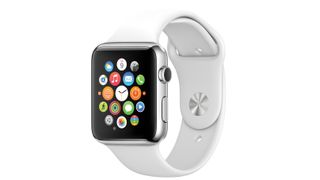

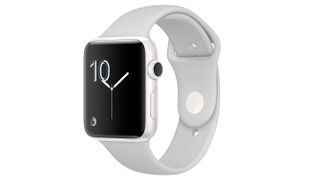
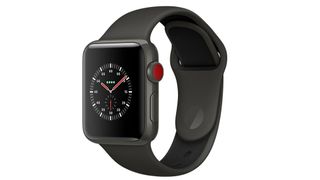
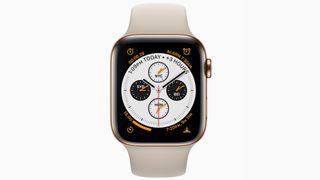
The Apple Watch Series 1 is easier to find through third-party retailers, but Apple has now stopped selling the device.
Alongside the Series 1, Apple announced the Watch Series 2 (which we refer to as the Apple Watch 2 to make things a little simpler). This brought new technology like built-in GPS and water resistance and a slightly larger battery.
Apple is no longer selling the Watch Series 2, but you can buy find this from a limited number of third-party retailers.
2017’s smartwatch is called the Apple Watch Series 3 and it comes with LTE technology (if you want it) as well as a variety of fitness features and improved GPS.
the Apple Watch Series 4 followed in 2018 with a larger display than the other versions and some new heart rate features, too – allegedly accurate enough to detect atrial fibrillations (AFib), abnormal heart rates that could signify worrying behavior.
Last we have the 2019 edition, the Apple Watch Series 5, which introduced an always-on display: when you’re not directly looking at the watch, it switches to a monochromatic minimal version of your watch face so you can tell time. For the first time, the Apple Watch has its own self-contained App Store, letting you download straight to the watch instead of through an iPhone.
There are also little additions like a new internal Compass app that allows for more specific location information, like elevation – which in turn allows the Maps app to know which direction you’re facing. Small, but crucial.
Apple Watch price comparison
Largely the pricing for the Apple Watch works by how old the product is. If you want the Apple Watch Series 1, you’ll be able to find that for a lot less money than the Apple Watch 5.
Below we’ve got a live widget that will show you the latest deals for all the versions of the Apple Watch if you want to see the exact price right now. Bear in mind you can also get the Apple Watch 5, 4 or 3 on a contract because of the LTE features, and you can’t do that for the other two devices.
Apple Watch vs Apple Watch 3 vs Apple Watch 4 vs Apple Watch 5
- Original Apple Watch is cheapest, but it’s very difficult to find
- Apple Watch Series 1 is faster, but lacks Watch 2 features
- Apple Watch 2 has GPS, a brighter screen and is water-resistant
- Apple Watch 3 has a faster chipset and optional LTE
- Apple Watch 4 has a larger screen and an improved heart rate tracker
- Apple Watch 5 has an always-on screen and better location tracking
You can’t buy the original Apple Watch easily anymore, so here we’re going to break down the differences between the watches referred to as the Apple Watch Series 1, Apple Watch 2, Apple Watch 3, Apple Watch 4, and the Apple Watch 5.
Design
Until the Apple Watch 4, the series has been very similar in terms of design. (The Apple Watch 5 is virtually identical to its predecessor.) There have been a few minor changes, but the Apple Watch 4 marks the first time you can buy it in 40mm or 44mm variants. That allows for a slightly larger screen, plus there’s haptic feedback on the digital crown too.
The Apple Watch 3 and below come in either 38mm or 42mm versions. Only the Apple Watch 2 and Apple Watch 3 are waterproof though, so don’t try taking the original watch in the pool with you.
Display
All generations of the Apple Watch feature square displays, but the technology used differs. The Apple Watch featured an OLED Retina display with Force Touch at 450 nits, while the latter models have an improved technology that runs at 1000 nits. The Apple Watch 4 comes with a larger display too.
The Apple Watch 5 has an always-on display – a software trick that switches your watch face to a monochrome, minimalist version that drains less power.
Performance
You don’t need a huge amount of power in the Apple Watch, but each passing generation has been a little snappier. The Series 1 features an Apple S1P system on a chip, while the Series 2, Series 3 and Series 4 feature an S2, S3 or S4 in that order. The Apple Watch 5, predictably, has an S5 chip.
Each watch has featured 512MB of RAM, apart from the Apple Watch 3, which features 768MB. Afterward, Apple stopped announcing how much RAM comes in its smartwatches, so it’s likely the Apple Watch 4 has the same 768MB as its predecessor. The Apple Watch 5 reportedly has more, which could be up to 1GB.
The Apple Watch 5 has 32GB of local storage, some of which is taken up by watchOS but the rest can locally store music or other media. That’s double the 16GB of the Apple Watch 4 and Apple Watch 3.
Fitness
All versions of the Apple Watch feature a heart rate monitor, accelerometer, gyroscope and ambient light sensor. The Apple Watch 3 was the first time the device sported an Altimeter though, and the Apple Watch 4 has ECG features for the first time.
You can currently only use these in the US, but it’s thought the feature will be introduced to other watches in the next year or so.
For GPS, you will get that on the Apple Watch 2 and an improved version of the tech including Galileo and QZSS features is on the third iteration. The Apple Watch 2, 3 and 4 feature swimming modes.
Not fitness per se, but the health app has been refined over the versions, and the Apple Watch 5 includes menstrual cycle tracking.
Battery
The battery life of the Apple Watch has remained largely unchanged, and despite Apple hiding the exact capacity, its claiming 18 hours – which is fine, but not impressive by smartwatch standards.
As expected, the smaller (38mm and 40mm) versions of each model have a smaller battery inside than the larger (42mm and 44mm) one, but that’s largely because of the difference in case size.
Connectivity
Each version of the watch has Bluetooth and Wi-Fi technology built-in, but the Apple Watch 3, 4, and 5 have a cellular option. This means you can use an optional eSIM to give yourself a connection when on the move.
What iPhone do you need to use an Apple Watch?
Unlike Google’s Wear OS devices, the Apple Watch only works with one type of phone. You’ll need to have at least an iPhone 5 running iOS 10 or later to be able to use an Apple Watch or Apple Watch 2.
If you want an Apple Watch 3, you’ll need to have at least an iPhone 5S running iOS 11 software for the non-LTE version or an iPhone 6 to be able to use the LTE variant.
But if you’re buying a brand-new Apple Watch 5, you’ll need an iPhone 6S or later, which is the cutoff for watchOS 6, which is what that smartwatch ships with.
Apple Watch colors and sizes
A big change for the Apple Watch 4 is the size, so now it comes in 40mm or 44mm options.
All of the other models of the Apple Watch come in either 38mm or 42mm versions. Some color options are limited to certain size watches, but our simple advice here is go for the larger version if you want a watch with a bigger screen and you don’t mind spending a touch more.
It’s difficult to get the difference in size across here, but if you’re uncertain on size it’s worth trying each on in the shop to be sure. Below we’ve got three examples showing off the four different sizes, as well as a comparison of the screen sizes.
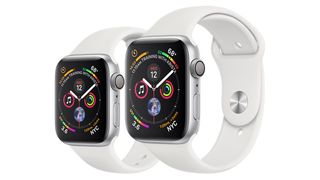
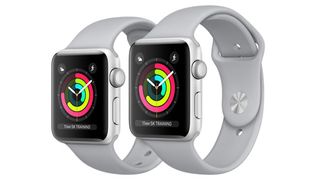
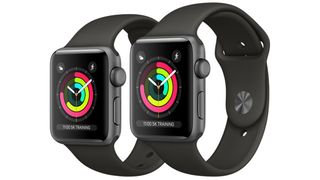
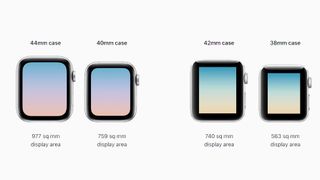
You’ve then also got to choose the color of your watch as well as what material you want it to be made of. The Apple Watch 4 comes in gold, space grey or silver if you want it to be made of aluminum, and the same colors come in stainless steel too.
White and grey are also color options if you choose the ceramic version of the Apple Watch 3, but these are much more expensive and are called the Apple Watch Series 3 Edition. These are now hard to come by as Apple doesn’t officially sell them.
There’s also the Apple Watch Nike+, which is the same device as the Apple Watch 3 but comes with exclusive watch faces, the Nike+ Run Club app pre-loaded and a choice of lots of Nike branded sports bands.
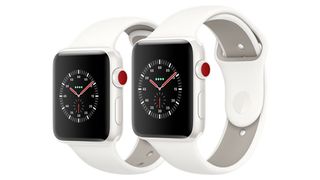
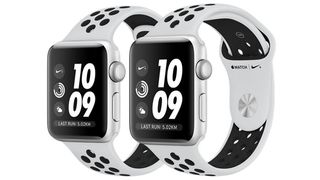
That’s not all though. If you like the idea of a handcrafted leather strap, you may like the look of the Apple Watch Hermès. Again, it’s the Apple Watch 4. but here you get an exclusive watch face using the Hermès Carrick font as well as high-end leather straps for your wrist.
The Apple Watch Series 1 is only available in aluminum in space grey or silver.
Apple Watch bands and straps

There are dozens of straps sold by Apple that offer a huge variety of styles for your wrist. When you first buy your Apple Watch you’ll have a strap included, but you can buy and easily switch out different straps that you buy separately.
There are material and color options available including woven nylon, Nike sport, leather, bracelets and much more. Any Apple Watch strap works with any Apple Watch, as long as you’ve got the right smaller or larger size watch.
Plus there are lots of third-party bands available too, but make sure you get the right size as it won’t support all watch straps.
Apple Watch software updates
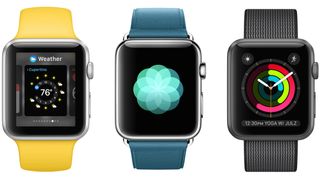
Apple’s watchOS 5 update gave every model a boost apart from the original Apple Watch. If you’ve got the older model, you’ll be stuck at watchOS 4 as the company doesn’t plan to give it anymore updates.
It’s worth looking at the features within watchOS 5, and if you get an Apple Watch be sure to update it as soon as possible to make full use of all the new features.
You may have heard that watchOS 6 is the latest version of the company’s smartwatch software, but it won’t be out until later in 2019. The new upgrade will bring an App Store to the device as well menstrual cycle tracking and a new feature to tell you when you’re in locations that may damage your hearing.
Apple Watch apps and watch faces

Since the original Apple Watch, we’ve seen the company grow its titles that you can use on the watch as well as the amount of watch faces you can switch around to give the screen a different look.
For a full guide to our favorite bits of software on the wearable, check out our best Apple Watch apps guide as well as best Apple Watch games and best Apple Watch faces.
What’s next for the Apple Watch?
If you’re planning to buy an Apple Watch soon, now is the perfect time. The Apple Watch 4 launched in early September 2018 – so we expect it to be at least a year later until we hear about an Apple Watch 5.
It may be even longer too, so if you’re to set buy a new watch in the coming months, you’re sure to be having it for the longest lifespan possible. It also means the price of the Apple Watch Series 3 and some of the other models has dropped too, so it’s well worth upgrading soon if you’re certain it’s a device made for you.
Got your Apple Watch? Learn how to use it
Below are a selection of the how to guides we have at TechRadar to help you understand some of the complicated parts of setting up, customizing and using your new smartwatch.
